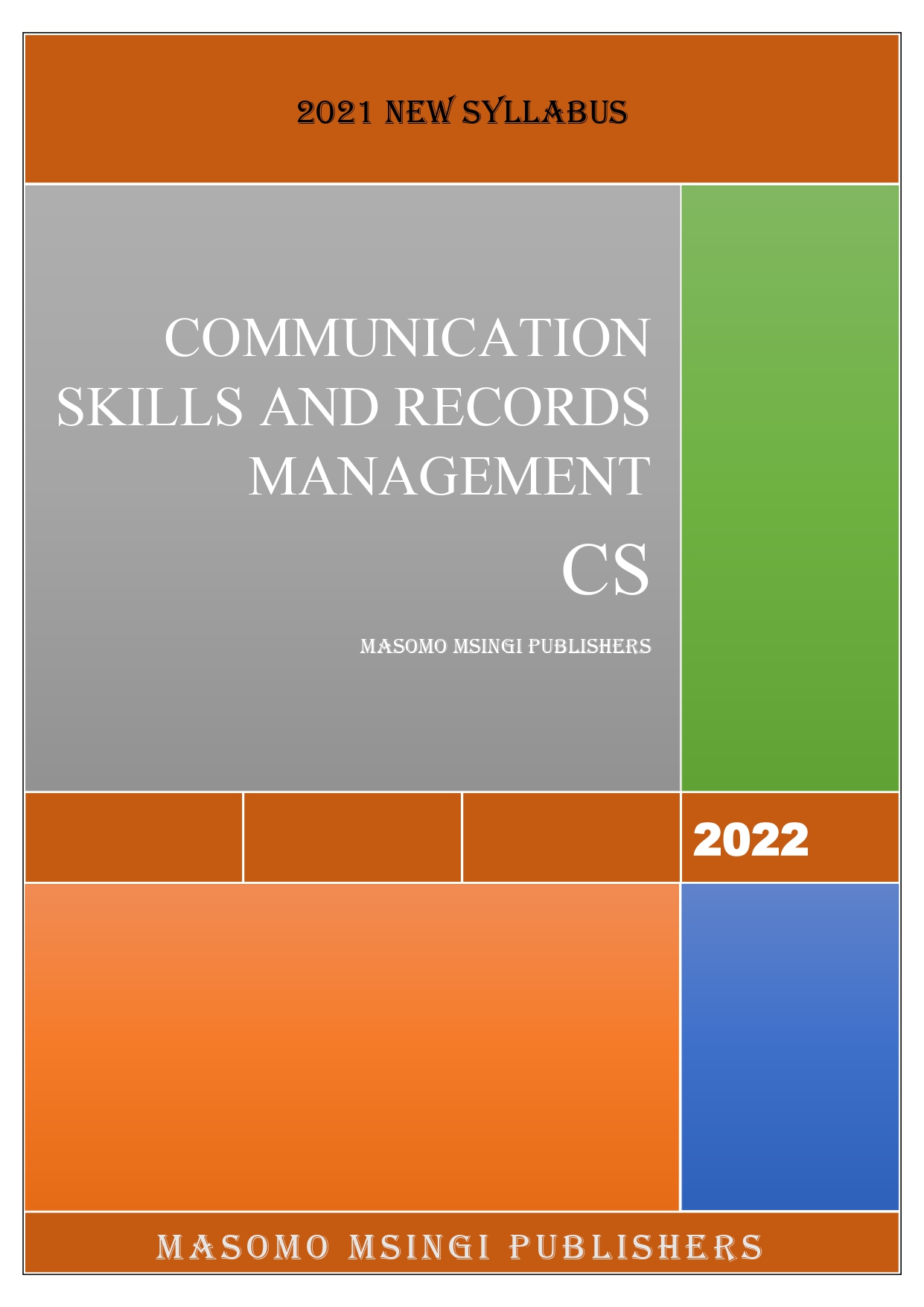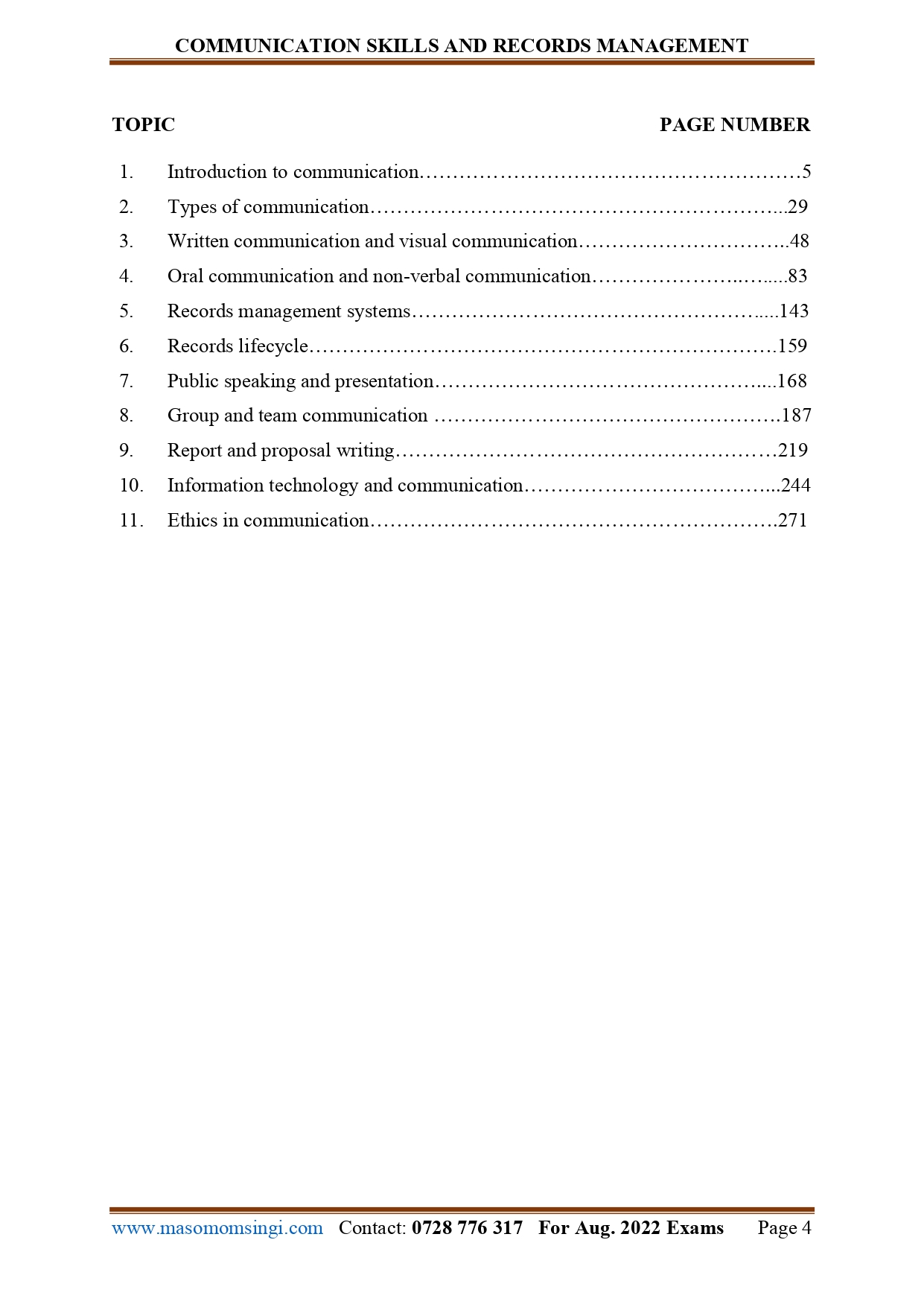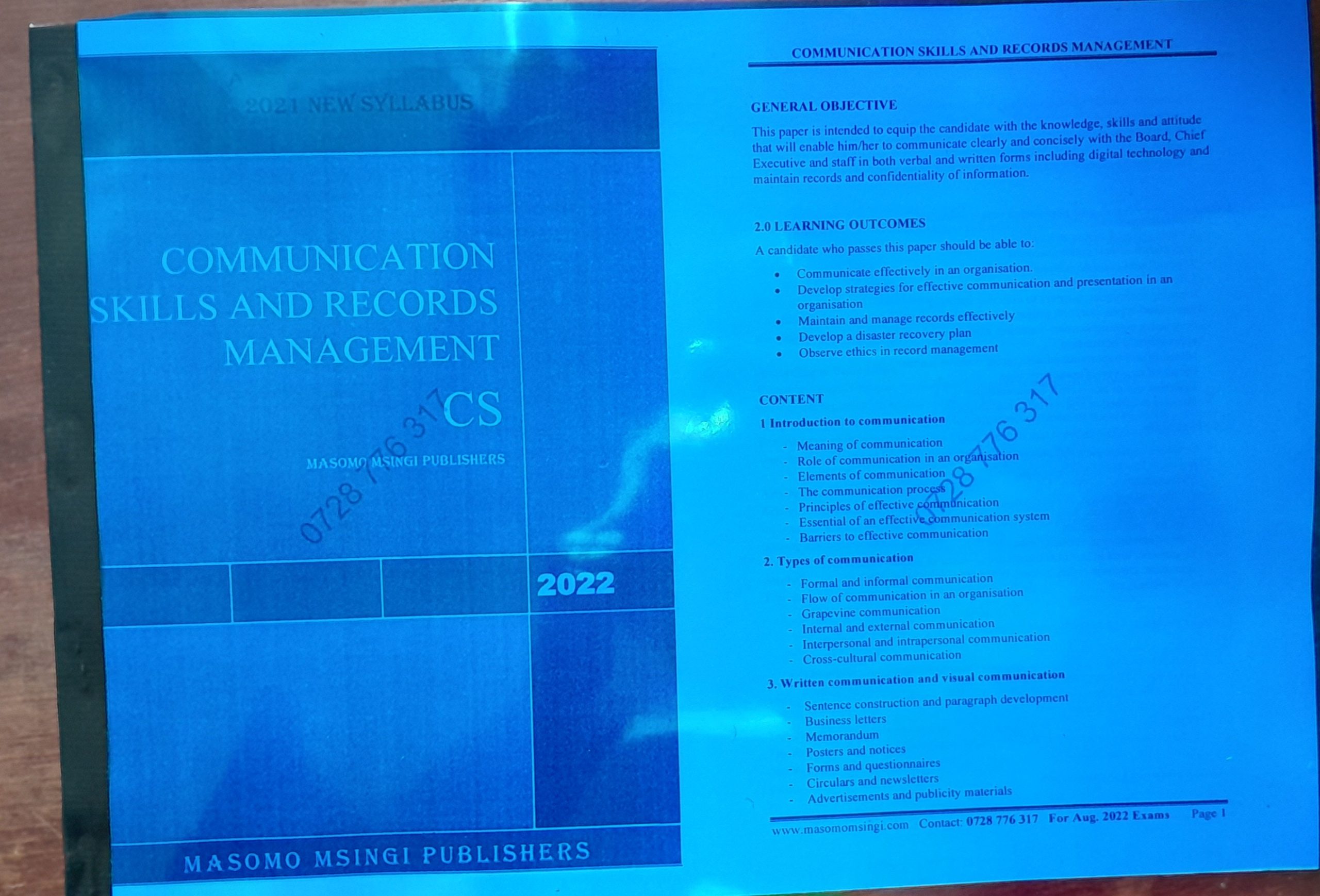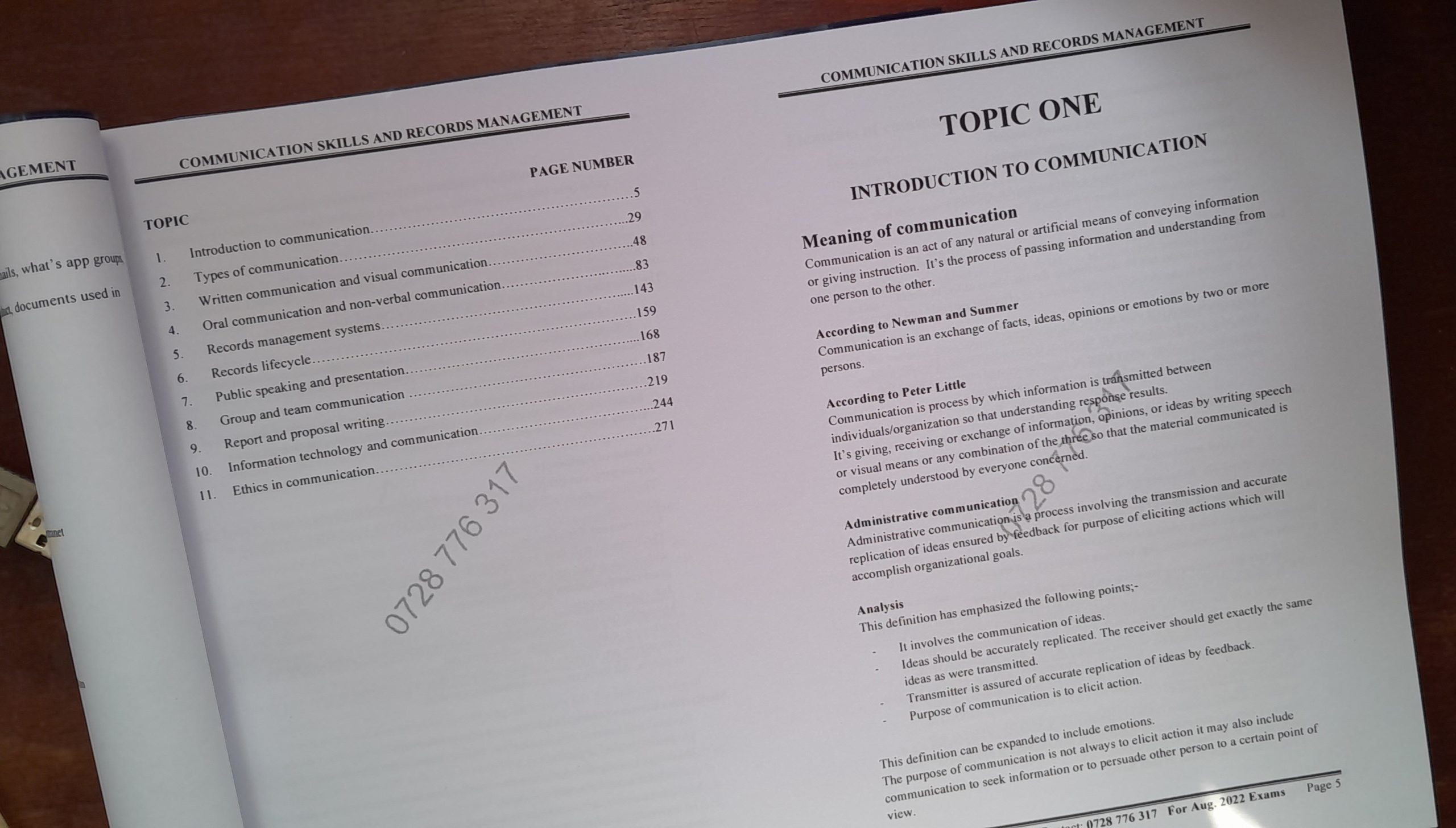
MASOMO MSINGI PUBLISHERS APP – Click to download and access all our materials in PDF
GENERAL OBJECTIVE
This paper is intended to equip the candidate with the knowledge, skills and attitude that will enable him/her to communicate clearly and concisely with the Board, Chief Executive and staff in both verbal and written forms including digital technology and maintain records and confidentiality of information.
2.0 LEARNING OUTCOMES
A candidate who passes this paper should be able to:
- Communicate effectively in an organisation.
- Develop strategies for effective communication and presentation in an organisation
- Maintain and manage records effectively
- Develop a disaster recovery plan
- Observe ethics in record management
CONTENT
1 Introduction to communication
- Meaning of communication
- Role of communication in an organisation
- Elements of communication
- The communication process
- Principles of effective communication
- Essential of an effective communication system
- Barriers to effective communication
- Types of communication
- Formal and informal communication
- Flow of communication in an organisation
- Grapevine communication
- Internal and external communication
- Interpersonal and intrapersonal communication
- Cross-cultural communication
- Written communication and visual communication
- Sentence construction and paragraph development
- Business letters
- Memorandum
- Posters and notices
- Forms and questionnaires
- Circulars and newsletters
- Advertisements and publicity materials
- Documents used in business transactions – letter of enquiry, catalogue, quotation, purchase order, invoice, credit note, debit note, others
- Job application cover letter, curriculum vitae and resume
- E-mails
- Visual communication – graphs/charts/tables/diagrams/pictures
- Oral communication and non-verbal communication
- Meaning of oral communication
- Importance of oral communication
- Types of oral communication-face to face and telephone conversations
- Effective listening-The listening process, principles of effective listening, listening techniques, barriers to effective listening
- Interviews-types, purpose, preparation and conduct of interviews
- Persuasive communication- meaning, objectives, creating persuasive messages, approaches to persuasion
- Meaning and importance of non-verbal communication
- Forms of non-verbal communication
- Effective use of non-verbal communication
- Barriers to effective non-verbal communication`
- Writing skills
- Sentence construction and paragraph development
- Business letters
- Memorandum
- Posters and notices
- Forms and questionnaires
- Circulars and newsletters
- Advertisements and publicity materials
- Documents used in business transactions – letter of enquiry, catalogue, quotation, purchase order, invoice, credit note, debit note, others
- V and resume
- Public speaking and presentation
- Effective presentation skills
- Audience analysis
- Selecting and researching the topic
- Preparation and organisation of an effective presentation
- Structure of presentation
- Presentation aids
- Public speeches-structure and delivery of public speeches
- PowerPoint presentations
- Group and team communication
- Group communication networks
- Team communication
- Communicating in virtual groups and teams-group e-mails, what’s app groups, social media
- Meetings- types, role of members, preparation, conduct, documents used in meetings
- Conferences and symposia
- Report and proposal writing
- Types and purpose of reports
- Structure and content of reports
- Types and uses of proposals
- Structure and content of proposals
- Writing of formal reports and proposals
- Information technology and communication
- Role and impact of technology in communication
- Communication networks- internet, intranet and extranet
- Teleconferencing and video conferencing
- Webinar
- Wireless technology
- Ethics in communication
- Role of ethical communication in an organisation
- Principles of ethical communication
- Ethical issues in communication
- Enhancing ethical communication in an organisation
- Factors influencing ethical communication
- Ethical dilemmas in communication
- Handling ethical dilemmas in communication
SAMPLE WORK
Complete copy of CS Communication Skills And Records Management Revised Notes is available in SOFT copy (Reading using our MASOMO MSINGI PUBLISHERS APP) and in HARD copy
Phone: 0728 776 317
Email: info@masomomsingi.com

SAMPLE NOTES
Complete copy of CS Communication Skills And Records Management Revised Notes is available in SOFT copy (Reading using our MASOMO MSINGI PUBLISHERS APP) and in HARD copy
Phone: 0728 776 317
Email: info@masomomsingi.com
TOPIC ONE
INTRODUCTION TO COMMUNICATION
Meaning of communication
Communication is an act of any natural or artificial means of conveying information or giving instruction. It’s the process of passing information and understanding from one person to the other.
According to Newman and Summer
Communication is an exchange of facts, ideas, opinions or emotions by two or more persons.
According to Peter Little
Communication is process by which information is transmitted between individuals/organization so that understanding response results.
It’s giving, receiving or exchange of information, opinions, or ideas by writing speech or visual means or any combination of the three so that the material communicated is completely understood by everyone concerned.
Administrative communication
Administrative communication is a process involving the transmission and accurate replication of ideas ensured by feedback for purpose of eliciting actions which will accomplish organizational goals.
Analysis
This definition has emphasized the following points;-
- It involves the communication of ideas.
- Ideas should be accurately replicated. The receiver should get exactly the same ideas as were transmitted.
- Transmitter is assured of accurate replication of ideas by feedback.
- Purpose of communication is to elicit action.
This definition can be expanded to include emotions.
The purpose of communication is not always to elicit action it may also include communication to seek information or to persuade other person to a certain point of view.
Main aspect of communication
- Communication must have a source (sender)
- Communication must have content (message)
- Communication must have a media
- Communication must have a destination: i.e. recipient
- Communication must have a feedback.
Importance of communication
- Communication can be described as the life blood of the business
- No business can develop in the absence of effective external and internal communication.
- Communication is a vital tool of management.
- One of the major functions of an office is communication. This involves receiving, recording, processing of information and communicating the information two various functions of the organizations.
Importance of communication can be discussed under two points of view.
- Internal communication
- External communication.
Importance of internal communication
Internal communication refers to exchange of information or message between persons of same organization, e.g. between employer and employee.
- Better understanding between employer and employees.
If complaints of employees are forwarded to employer on time and in the right way it will minimize the chances of misunderstanding.
- Greater efficiency.
The sound communication system enables the management to instruct the supervisions and subordinates on changes of policy – this results to the increase in efficiency of workers.
- Effective co-ordination:
Effective communication leads to effective co-ordination of employees e.g if demand increase the marketing department will inform the production department to increase its production.
- Proper communication avoids losses:
If there is a machine breakdown or shortage the management can be informed quickly to take timely action to avoid any possible losses.
External communication.
This refers to exchange of information between an organization and other organizations or persons outside the organization.
The following facts indicate the importance of external communication.
- Good reputation
Effective communication with customers and either business enables company establish good reputation this increases prestige of that company.
- Improvement in public relations
When a company communicates with general public to keep them informed of its activities more people become interested to deal with that company.
- Better business prospects
Due to good communication the company can abstract more customers.
- Choice of customers
A company can get information about the liking and disliking of customers. This information will help company produce goods according to the choice of customers.
- Government department
The business will deal with licensing authorities, foreign trade offices, custom authorities, banks and other financial institutions. All these institutions require good communication when negotiating.
- Job requirements
Most jobs require communication skills such as personnel public relations, marketing, editing, research, advocates, etc.
Executives are expected to make speeches they are expected to give interviews to media. All these require communication skill.
Similarities between internal and external communication
- External and Internal communication, both influences the growth and productivity of an organization.
- Thinking carefully and designing the message that to be transferred is required for both the means of communication.
- Multiple channels and media can be utilized for effective communication.
- The conversation takes place not one-way communication.
- Regular feedback and changes are proposed to develop the organization.
Good communication skills are highly important to convey the message properly and maintain communication consistently.
Key differences between internal and external communication
- Audiences are different comparatively in internal and external communication.
- Internal communication can be formal or informal but external communication is always formal and well documented.
- Internal communication is purely to transfer messages but external communication focuses on some other elements too, such as advertisement, maintaining relationships with customers.
- Both external and internal communications are regular but the occurrence of internal communication is higher than external communication.
- Internal communication covers only organization but external communication covers the whole business environment.
- Various modes of communication can be seen in both, but mostly preferred modes are different in internal and external communication.
Role of communication in an organisation
- Communication promotes motivationby informing and clarifying the employees about the task to be done, the manner they are performing the task, and how to improve their performance if it is not up to the mark.
- Communication is a source of informationto the organizational members for decision-making process as it helps identifying and assessing alternative course of actions.
- Communication also plays a crucial role in altering individual’s attitudes, i.e., a well-informed individual will have better attitude than a less-informed individual. Organizational magazines, journals, meetings and various other forms of oral and written communication help in moulding employee’s attitudes.
- Communication also helps in socializing. In today’s life the only presence of another individual fosters communication. It is also said that one cannot survive without communication.
- Communication also assists in controlling process. It helps controlling organizational member’s behaviour in various ways. There are various levels of hierarchy and certain principles and guidelines that employees must follow in an organization. They must comply with organizational policies, perform their job role efficiently and communicate any work problem and grievance to their superiors. Thus, communication helps in controlling function of management.
Elements of communication
- Motivation
This is the basic urge beneath the communication. It is the wider reason why communication takes place. e.g. in a company the urge to communication is to ensure that this year’s profits are higher than last years.
- The aim
This is the more particular reason why communication has been under taken. The aim of communication can be: to inform to warn or to initiate a particular action
- Information:
Is the material from which communication would be constructed. The actual content to put across to the listener or reader. An information doesn’t need to be factual it can be an opinion, an idea or combination of ideas and opinions
- The sender
This is the person responsible for sending the communication it can be an individual or a group such as a company, a department, a government ministry etc.
- The message: after defining the information to be conveyed, the sender puts this into the best form in a process called encoding. When information has been encoded it is referred to as a message. A message takes the form of a letter, a memo, telephone call, or a shrug of shoulders.
- The media
This is a larger group of ways of communication within which particular ways of communication can be classified. There are three main media.
- Written communication e.g. letters, memo, books, posters
- Oral communication: this is communication using word of mouth e.g meetings, lectures, telephones or discussions.
- Visual communication: it takes the form of photographs, blackboards etc.
In addition to these three media we also have non-verbal communication that is combination of gestures, expressions, tone of voice, position, posture, etc.
- The channel:
This the physical means by which message is conveyed for written communication channel may be notice board, postal office.
For oral communication, it may be personal interview, committee meeting, or public telephone call.
For visual communication, the channel may be computer printer, fax system or printing press.
- The receiver:
Is the person or body which receives the message.
It can be an individual or an organization.
- The noise:
Noise is used to refer to any factors which prevent proper exchange of information apart from that from the sender or receiver. Noise can be physical e.g. typewriters or the telephone bells which interrupt meetings, or it can be some other form of interference such as bad telephone connections, poor handwriting in letter, conflicting messages, e.g. in oral communication the visual expression conveys a difference message from that being given orally.
- Distortion:
Takes place at the encoding or decoding stage. During encoding the sender may encode the message in such a way that it conveys a different meaning from that he or she intended to give. During decoding the receiver may interpret the message in a different way from that intended by the sender. This may lead to distortion of the message.
SAMPLE WORK
Complete copy of CS Communication Skills And Records Management Revised Notes is available in SOFT copy (Reading using our MASOMO MSINGI PUBLISHERS APP) and in HARD copy
Phone: 0728 776 317
Email: info@masomomsingi.com
- Feedback:
This is the name given to the message which the sender receives from the receiver to show the acceptance or disapproval of message, such a smile
OBJECTIVES OF COMMUNICATION
- To inform
One of most important objectives of communication is passing and receiving information about of particular fact of circumstance.
An organization can inform consumers about its products, availability of credit, availability of raw materials, or about government rules and regulations.
It can also communicate to inform staff about the latest development in the field of science and technology.
Within the organization you can inform employees about job assignments, or inform them of general information on policies and activities of organization.
- To advice
Information is factual and objective, advice on the other hand involve personal opinions. It is subjective and neutral.
When advice is given to person he /she may use it or decide not to use it. An advice is aimed at influencing the opinion or behaviour of another person.
Advice flows downwards or horizontally, e.g. from a doctor to patient and not vice versa.
- To order
An order is an authoritative communication; it is a directive to somebody (subordinate) to do something to modify or not to do something.
Orders flow from top to bottom.
- To suggested (make suggestion)
A suggestion is different from other forms of communication. In other forms it flows from superiors to subordinates but, a Suggestion may flow from subordinate to superior. A suggestion is mild or subtle and it moves in all directions.
- To persuade
This is communication aimed at influencing the attitudes, feelings or beliefs of others.
- To Educate
Education is a conscious process of communication. It involves teaching and learning, its main purpose is to widen knowledge and improve skills.
- To warn someone
If employees don’t abide by the rules of the organization they will be warned.
- Raise the morale.
Morale-stands for mental health.
It’s a powerful factor representing the sum of many qualities such as courage fortitude, resolution and confidence.
- To motivate
Motivation is very close to rising of miracle. It means to energize and activate a person and challenge his or her behaviour towards the attainment of desired goals.
Effects of poor communication
- Confusion
- Mistakes
- Wastage
- Accidents
- Frustrations
- Low morale and lack of motivation
- Strikes and unrest
- Poor transfer of information
- Feeling of dissatisfactions
The purpose of communication in business
- Inform others and being informed
- Evaluating an organizations input & output
- Directing others and being directed
- Influencing others and being influenced
- Integrating management functions.
- Facilitating internal and external communications.
The importance of communication
- Better performance
- Efficiency and timely delivery
- Improved customers relations
- Creation of better business prospective
- Better management
- Harmony among employment
- Coordination
- Proper resource utilization
- Building of business reputation
Areas of emphasis when defining communication
- The process of communication involves communication of ideas.
- The ideas should be accurately replicated ie .reproduced in the receiver’s mind.
- The transmitter is assured of the accurate replication of ideas by feedback.
- The purpose of any communication is to elicit action.
Note:
- The above definition covers almost all aspects of communication but should also include two important aspects
- The concept of idea should be adequately enlarged to include.
- Even in the administrative communication the purpose may not always be to elicit action but to
- Seeking information
- Persuading others etc.
- All communication has to be originated produced, transmitted, received and understood.
- The main aspects of communication which need to be considered are;
- The source of communication i.e… the message – (sender)
- The contents of communication is produced eg dictation – (Message)
- The method of transmission e.g… faxing (channel)
- The process involved in receiving e.g… mail handling
- The destination of the communication i.e..recipient. (receiver)
- The understanding of the communication (feedback)
- We can therefore conclude that communication exists when,
- there is a person ( a sender or transmitter) desirous of passing on some information
- There is another person (receiver) to whom the information is to be passed on.
- The receiver partly or wholly understands the message passed on to him (message)
- The receiver responds to the message ( feedback )
Forms of communication in a business venture
With Customers
- Most of the communication with customers is one way i.e… through;
- Advertisements
- Direct mail
- Sales promotions etc
- One can experience a two way communication with customers when;
- There is physical contact with customers
- Telesales
- Questionnaires
- Taking orders or deliveries
- Dealing with complaints
- One can experience a two way communication with customers when;
With Staff
- communicating with staff occurs when
- Delegating tasks
- Appraising performances
- Resolving grievances EST
.
c) Communicating with supplier
- Placing orders
- Dealing with returns outwards/ or replacements
- Dealing with payments
- Accounts reconciliation (creditors)
MASOMO MSINGI PUBLISHERS APP – Click to download and access all our materials in PDF
d) Communicating with owners
- Annual reports –AGM
- Monthly or weekly returns for small organization.
Communicating with the community
- Involvement in various projects i.e… community projects
- Environmental issues
- Marketing activities
- Employment issues.
SAMPLE NOTES
Complete copy of CS Communication Skills And Records Management Revised Notes is available in SOFT copy (Reading using our MASOMO MSINGI PUBLISHERS APP) and in HARD copy
Phone: 0728 776 317
Email: info@masomomsingi.com


